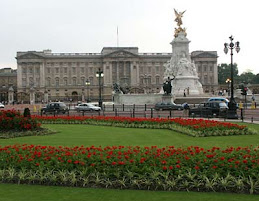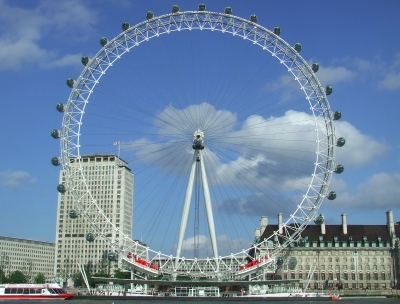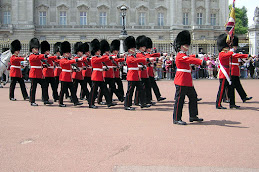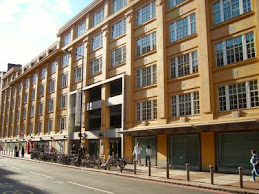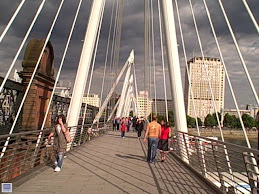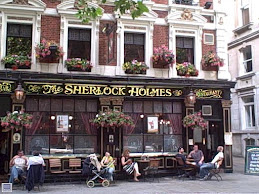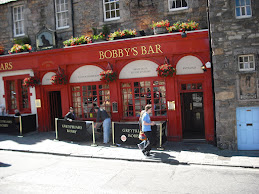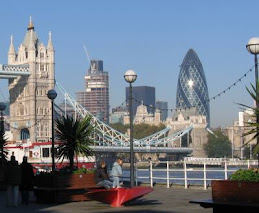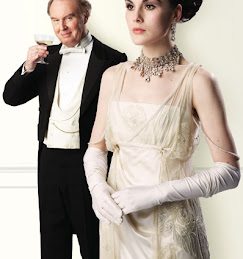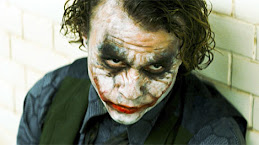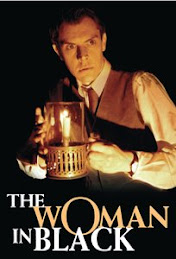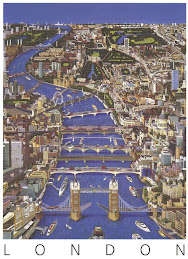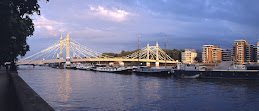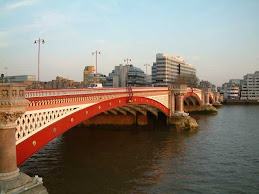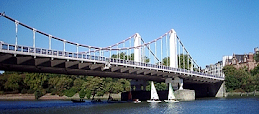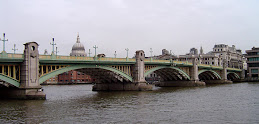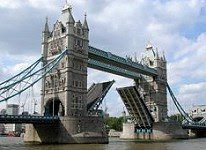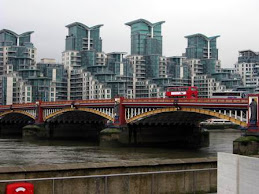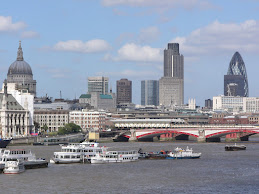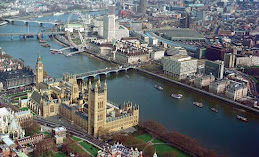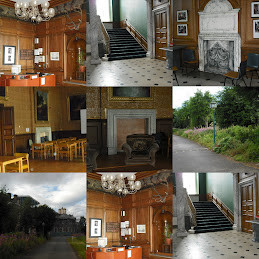
Meet Kevin the Tour Guide: An Introduction to the Library
Upon entering the British Library, the United Kingdom’s national library where every published work must come first, the class lingered in the library foyer while waiting on our tour guide to guide us through the library. Of interest upon entering the gigantic library was a bronze sculpture by Bill Woodrow entitled “Sitting on History”. This 'bronze book' served as a sitting area for patrons and was bolted to its present location by a heavy and very large chain with an enormous bronze ball attached. Of course, we all had our turns at sitting on it, as it was a combination artistic piece and allowed public seating area. Another interesting point of interest located in the library foyer was a digital standing tabletop user display on a stand of a small sample of the library collection's digitized historical books made available to manipulate by touch. One could turn the pages, rotate the page, make the text pop out for better visibility or reading purposes and turn on audio for some examples. What fun to experiment with this interactive digital touch display of a some popular items in the collection and what an excellent idea to make this digitized format accessible to all that could stand and manipulate it by the touch of a finger. It was very visible, intuitive and navigitable option to preview materials that many could use foe educational and entertainment purposes. It was a nice 'taste' of the collection in the foyer, prior to entering the library!

Mr. Kevin Mehmet was our tour guide for the day and he approached us not too long after our wait in the library foyer. He has worked at the British Library for 25 years and stated that he also is a Librarian/Donations Officer for the library collections. His job was explained to be one where he sifts through all items and keeps it all. The British Library was explained to be a “working library” with a role to deliver. The library obligations were that of acquiring items for the collection, retaining items, making them available, and maintaining a catalog entry for each item. Kevin told the class that there were up to 3,000 employees there. Of great importance in learning was that the library acquires the entire national bibliographic items. Everything published must be sent to the British Library. Not all items have serial numbers and not one item will ever be disposed of. Kevin labeled this non-disposal of the collection as a “ball-and-chain” effect, as with the bronze book sculpture in the library foyer entrance that has a ball attached to the book signifying its attachment and permanence as a part of the British Library collection!
A Tour of Floor One & Introducing the Collection and Storage:
It was learned that the collection was stored below ground for the St. Pancreas location, yet the entire collections that gross well over 150 million items are stored upon shelves in other locations spread across London and in Yorkshire. The number that was stored below ground at the British Library numbered in the 35 million with there being lots of shelving for proper storage. The entire space where the items are stored was explained to be a huge, open space. In 1961, the collection was subdivided, with musical books being separated from the artifacts. This diversification of the items in the collection made the way for a new building that severely needed re-modification. It was then that the books were legally separated from the museum to a new building in 1980. All records were finally placed under one roof in 1997, and Kevin explained that the new building was then completed for the final move! Of interest was that this move was the largest move in the United Kingdom, with over 20 million items in the collection being transferred to the new location. Wow and Whew!!
Moving past the main entrance/foyer of the British Museum, the class stopped in front of four busts of important individuals mounted on a side wall that Kevin Mehmet, our tour guide, decided to quiz us on to find out how much we knew. To his disappointment, not a one of us knew who the chocolate colored bust was, but we were informed this was Sir Hans Sloan, the scholar, Botanist, collector of manuscripts, physician and traveler who brought chocolate to the western hemisphere to make the ever famous “Hershey Bar” (Sir Hans Sloan and the British Museum). It now made since as to why the bust was brown in color. Kevin taught us that Sir Hans Sloan believed “knowledge should be shared”. When Sloan died, the government took over his large collection and his home (the 'Montague’ house) and is the location of the British Museum today.
The core of the British Library is the largest philatelic collections and encompasses approximately a quarter of a million items (a collection of stamps, postmarks and related materials). In order to catalogue such a collection requires that the individual frames be pulled items, which is quite a cumbersome task. Kevin pointed out a wall display surprisingly found in a busy corridor that was in essence an index as well as an actual display of some of the very valuable and ancient stamp collection. Of interest contained in this collection is the most valuable stamp in the world, priced at over four million dollars and was purchased by Queen Victoria in 1847. It looked just like any paper stamp and I stood in disbelief and amazement when looking at it! I squinted hard to get a good look at the details and to locate the quality and detail found on it. As there were only fourteen of them in the world, it was made as a commemorative stamp.
Moving to another area that leads straight into the Reader Registration area was a foyer containing a large glassed case on a large platform. A model within the case that took on the shape of a large vessel such as a cruise ship was that of the library. The architect who designed it was in the Navy and it was presumed that is why it was artistically designed in this manner. Of interest was the tail end of the library that closely resembled the back of a cruise ship with a swimming pool that is commonly found in this location on such a luxury vessel. I thought it was very interesting that below this model was a cross section of a shelving tank that collects water to shift water away from the collection. Kevin told our class about huge freezers that can be found below ground that keep the books dry for preservation purposes. Interestingly, we were told it was meant to look like a prison block.
The collection is one that grows on average approximately 8 miles per year! What that may equate to is undetermined, but rest assured it is a grand number. This collection is the largest collection in the United Kingdom and the third largest collection in the world! We learned on this day that the Library of Congress is the second largest collection in the world!
Accessing the Collection: Reader Registration
The British Library ensures that they know who patrons are and where they come from prior to their accessing the collection. It is also mandatory that patrons know what they are looking for prior to accessing the collection. There is not a subject index and Kevin explained that the British Library is not particularly a user friendly library. One must know a little about what they are seeking prior to coming in. There is an online application system available or a “reader registration” system in place. Following application, an interview with library staff takes place to discuss what the patron is researching. A mechanical dispatcher point is a process where an item requested is transported to the immediate location of the patron. The item in the collection is sent back to the dispatch room so that the item can be brought back to the patron within a timely manner. Once a patron has a “pass” for reader access, it is given for all reader areas in the library. As a class, a smile was found on each student’s face as Kevin told us “it is easier to get to heaven than to books”. After receiving a pass, a patron can then order the material needed. A print out of a ticket is the next step that includes the patrons’ name and what is needed. Lastly, the library workers take the ticket (two tickets per book) to the mechanical dispatcher room to locate the item. One ticket marks the spot where the book was retrieved from the shelf and the other ticket stays with the book. It takes up to one hour to deliver the item(s) to the patron and Kevin informed us that the government dictates this. It helps to keep the library workers on their toes, as they are busy bodies, having to keep a very tight schedule. As our tour guide stated, it can be a challenge if one “fiddles around”! To review, the process of checking out an item from the collection entails scanning the item, bar coding it into the software, putting the requested item(s) in the book retrieval computer system queue. Following this initial work, the ticket is placed in a bar coded basket, pushed in a tray on a conveyer belt to be sent to the appropriate section of the library through a door that opens upon turning on the conveyer. Amazingly, an optical scanner directs the basket to the correct room. The reader pass system takes it to four unique systems internally that work cooperatively. A light goes off at the department when it is ready. I think that we were all taken back with this entire electronic process and I tried my best to envision the entire elaborate labyrinth of intake and retrieval that required specification, compartmentalization and efficiency for this mechanized process to work!
Cataloguing & What You Need to Know About ("WYNTKA")...Special Collections
Something new that was learned during this tour is how the United Kingdom catalogs its collection using a classification that is all together different from that of the United States. While the system used is a close cooperative cataloguing system to the Library of Congress, the United Kingdom uses the Anglo American Cataloguing System. This system works close to the Library of Congress in that there is a division by language. There are 26 items that are catalogued in a record. As with the organizational system used at the St. Paul’s Cathedral library, “Size” was of importance and is central to this cataloguing system. To explain the organization and location of items in the collection, a grid reference (classification mark) is assigned each item on the binding and designates the point of location, the correct floor and quadrant of the building. The cataloguing process entails a record that includes items such as the date of publication and who the publisher is. The British Library has to have a copy and comes in the form of a “die stamp”, with a minimum of three per every plate. It is necessary that cataloguers check the Cataloguing in Publication (CIP) data when cataloguing items, so cataloguers retrieve a copy as done in the United States by copy cataloguers and those who are checking for accuracy (i.e. Retrieving CIP from LOC or other catalogs). After this information is gathered, the item is retrieved.
Kevin let us know that circulation is down as the collection is considered 'low use' in relation to its gigantic size. There will always be spacing concerns for an ever growing collection!
There are many famous works in the collection at the British Library, such as Codex Sinaiticus (a fourth century manuscript of the Greek Bible; a sacred text) and Beowolf! With such a treasured collection, the British Library is known as the most popular national libraries in the world! I learned that nearly every language in the world is represented in the immense collection and for each language there is a curator that can speak it fluently. The special collections base of over 90 thousand items stems from King George III’s ancient book collections of subjects such as math, science and religion. This special collection is encased in visible glass walls on the second level, actually within a glassed in tower that can be viewed from any almost any point in the front of the library, as the books are stacked from the floor to the ceiling upon shelves along with a statue of King George III in front of the “King’s Library”. I gasped when viewing this expansive collection and learning. The statue was designed by Peter Turnerelli in 1812. I just could not believe the wonderful condition that the books appeared to be in and could only dream of having one in my hand to thumb through!!

An Atlas of the World is another special collection item that was given to the British Library by the Dutch to mark the restoration of the Protestant Church. It is an item of tremendous size and was preserved back in 1956. The library kept as much of the original binding as possible, as Kevin stated it tells a story, “don’t judge a book by its cover”. The elaborate cover of the Atlas was hugely expensive in that only someone like the King of England could afford. The cover of the atlas has the national emblem, the fleur de le theme and was bound in leather and given to the British Library by King George in 1820.

Another part of the special collections includes the Maps Seminar Room. To get to this area, the class followed our tour guide very quietly through staff office areas. Once there, everyone was allowed to look over the reading room from above and what a spectacular view it was which served as an excellent photo and video opportunity!

Mr. Kevin Mehmet made a point to discuss some trends that have been discovered that he seemed to be a bit alarmed by. He predicted that greater than 40 percent of the collection by the year 2020 would be 50 percent physical copies and 50 percent electronic copies. Kevin stated that paper is being phased out. He also stated that there is more influx today of collection items with approximately 75,000 items per day coming in!! A problem he foresaw is that it will be much harder to keep up with electronic access as technology evolves faster than what seems to be a blink of an eye. I thought it was interesting that our guide said that a new filtering system will be a necessity where all may be able to access the collection with ease and efficiency. I also learned from Kevin that safeguarding copyright and digital media will continue to be a media and liability issue. With technology swirling ahead with advancements so swiftly, processing by format have become an additional issue for the library, as file formatting systems become smaller and smaller. These concerns were most definitely serious ones that hopefully advancements in technology will sort out.
Library Budget:
When asked about the library budget, our tour guide was quick to offer up an amount of about 20 million pounds per year. To enhance the budget, Kevin gave us some wonderful avenues to embellish what already seemed an unfathomable amount to me. Some examples are of digitizing sales or generating revenue by selling the catalogue to the world. The British Library already receives 100 million pounds from the government. Part of this budgeted amount goes to preservation alone, so the budget will always be of primary concern.
British Library
British Library Digital Services for Library Professionals
The King's Library: King George III Printed Books
British Library Centre for Conservation

